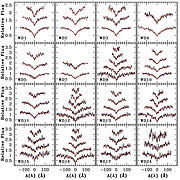100th Gemini Paper Reveals White Dwarf Progenitors are Prolific Mass Expellers
27 January 2005
A long-standing problem in understanding the evolution of stars has been determining the nature of the stellar progenitors for white dwarf stars. In particular, astronomers want to know how a rather massive star (up to seven times the mass of the Sun) can lose enough mass to become a white dwarf. Key questions include: Which main-sequence stars eventually end their life as white dwarfs? How much mass do they lose in late evolutionary stages? What process allows this to occur?
Some answers can be found in the 100th published paper based upon Gemini data. A Canadian, U.S., and Australian team led by Ph. D. student Jason Singh Kalirai of the University of British Columbia selected 24 individual white dwarfs[1] in the field of the rich open star cluster NGC 2099 (M37). This initial identification was made from analysis of deep wide-field imaging using the Canada-France-Hawaii Telescope. By following up on these imaging observations with subsequent spectroscopy from the Gemini North telescope, the team members assembled the largest spectroscopic sample ever obtained of white dwarfs in an individual star cluster. From these data they were able to constrain the relationship between the initial mass of a parent star on the main sequence and the final mass of the resulting white dwarf.
The result of their study indicates that stars with initial masses between 2.8 and 3.4 that of the Sun will lose 70-75% of their masses through stellar evolution.
The spectra for this study were obtained by Kalirai et al. using the Gemini Multi-object Spectrograph on Gemini North (GMOS-N) and the Keck Low-Resolution Infrared Spectrograph (LRIS) on Keck I.
Detailed modeling of the spectral features (geminiann05001b) allowed the team to derive pressures, temperatures and masses of the white dwarfs and from this infer their individual cooling ages. (A white dwarf’s cooling age is the total time that the star has spent since traversing from the tip of the asymptotic giant branch (AGB) down to its present white dwarf luminosity.) The team also calculated the progenitor main-sequence lifetime (tMS), which is the lifetime of the star from the time it turns on hydrogen burning in its core to the time it evolves to the tip of the AGB. To do this, the age of the parent stellar cluster (tcluster) was determined by fitting the appropriate isochrones to the “normal” stars of the open cluster NGC 2099. The team determined an age for the cluster of 650 million years.
A star’s lifetime on the main sequence (tMS), is simply the difference between the parent cluster’s age (tcluster), and the white dwarf cooling age (tcooling), which can be expressed as:
Not surprisingly, cooling ages vary between the individual white dwarfs in this open cluster, with the more massive ones taking the longest and the least massive cooling over the shortest period of time. In the equation above, greater values for tcooling correspond to a shorter main-sequence lifetime, and therefore to a more massive progenitor (since massive stars evolve faster than lower-mass ones).
Kalirai and the team constructed a plot relating white dwarf masses in NGC 2099 to infer masses for main sequence stars (geminiann05001c). In the process they not only doubled the number of data points on the initial-final mass plane (geminiann05001c – top), they also found a tight correspondence between main-sequence stars with an initial mass of 2.8 – 3.4 solar masses and a resulting white dwarf mass of 0.7 – 0.9 solar masses (geminiann05001c – bottom).
The paper “The Initial-Final Mass Relationship: Spectroscopy of White Dwarfs in NGC 2099 (M37)” by J. S. Kalirai, H. B. Richer, D. Reitzel, B. M. S. Hansen, R. M. Rich, G. G Fahlman, B. K. Gibson and T. von Hippel is the 100th Gemini paper published in major refereed journals. It appeared in The Astrophysical Journal, vol 618, pp. 123-128, 10 January 2005. Kalirai et al. also published a companion paper in the same issue reporting that the mean derived mass of their white dwarf sample is 0.8 solar masses, about 0.2 solar masses larger than for the mean seen among field white dwarfs. Surprisingly, all these white dwarfs are found to have hydrogen, none of them are helium rich.
Notes
[1] Three of the 24 identified stars turned out not to be white dwarfs and all stars in the study are fainter than V = 22.4



